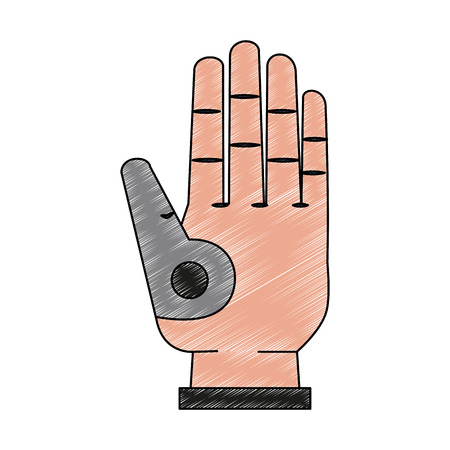Understanding Mangal Rekha within Indian Palmistry Traditions
The study of palmistry, or Hast Rekha Shastra, holds a special significance in Indian culture, where the lines on the palm are believed to reveal profound truths about an individual’s destiny. Among these lines, the Mangal Rekha—popularly referred to as the Marriage Line or Sub-Line—occupies a unique position, especially in matters of relationships and life growth. Rooted deeply in Vedic traditions, the interpretation of Mangal Rekha is not just about predicting marital status but also about understanding the broader spiritual journey connected to partnership, harmony, and personal development.
Historically, references to palmistry can be traced back to ancient Indian scriptures and texts like the Samudrika Shastra, which detail how physical features reflect a person’s inner nature and fate. The Mangal Rekha, situated below the little finger on the Mount of Mercury, has been observed by astrologers and palmists across generations, forming an essential part of traditional matchmaking practices. In many Indian households, especially during marriage proposals, elders consult palmists to examine this line for clues about compatibility, longevity of partnerships, and even auspicious timings for nuptials.
The spiritual significance of the Mangal Rekha is closely tied to Hindu beliefs surrounding karma and dharma. It is seen not merely as a marker for marriage but as an indicator of one’s capacity for emotional connection, commitment, and mutual growth. The presence, length, depth, and clarity of this line are interpreted through a lens that combines both astrological wisdom and practical cultural values unique to India.
In contemporary Indian society, while scientific perspectives are gaining ground, the fascination with palmistry remains robust. Many urban youth consult palmists out of curiosity or tradition before taking major relationship decisions. The Mangal Rekha continues to be a bridge between ancient wisdom and modern aspirations—reflecting evolving attitudes toward love, companionship, and personal fulfillment within the Indian context.
Thus, understanding the origins and cultural context of the Mangal Rekha provides deeper insight into how Indians perceive relationships—not only as social contracts but also as vital steps in one’s spiritual evolution. This enduring tradition exemplifies how India harmonizes age-old customs with present-day realities.
2. Identifying Mangal Rekha: Visual Cues and Common Variations
The Mangal Rekha, also known as the Marriage Line or Sub-Line, is a significant feature in Indian palmistry, especially when it comes to understanding relationship dynamics and life growth. Recognizing the Mangal Rekha on the palm involves careful observation of its position, length, clarity, and variations. In Indian tradition, this line is believed to reflect not only marital harmony but also the potential for partnerships and emotional fulfilment.
Locating the Mangal Rekha
The Mangal Rekha is typically found just below the base of the little finger (Mercury mount) and runs horizontally towards the centre of the palm. It is distinct from the Heart Line and is often shorter and finer. Some individuals may have a single clear line, while others might display multiple faint lines in this region.
Common Types of Mangal Rekha
| Type | Description | Indicative Meaning |
|---|---|---|
| Single Clear Line | A solitary, deep line with minimal interruptions | Stable marital life; harmonious relationships |
| Multiple Lines | Two or more parallel lines of varying depth | Multiple relationships or significant emotional connections in life |
| Forked Ends | The line splits at one or both ends | Potential for separation, misunderstandings, or dual commitments |
| Wavy Line | The line appears irregular or curved | Fluctuating relationships; emotional ups and downs in marriage |
| Broken Line | The line is interrupted by gaps or breaks | Possibility of breakups, temporary separations, or obstacles in married life |
Cultural Significance and Interpretations in India
In the Indian cultural context, elders and experienced palmist practitioners pay close attention to these variations when giving advice about marriage prospects and compatibility. For example, a strong and unbroken Mangal Rekha is often considered auspicious during matrimonial discussions. Conversely, multiple lines or a forked end may prompt further rituals or remedial measures to ensure marital peace. The interpretation of these lines aligns closely with local customs such as matching horoscopes (Kundali Milan) before marriage, reflecting the holistic approach Indians take towards relationships and personal growth.

3. Astrological and Spiritual Interpretations
In Indian culture, palmistry is rarely viewed in isolation; it is deeply intertwined with astrology and spiritual beliefs. The interpretation of the Mangal Rekha, commonly known as the Marriage Line or Sub-Line, goes beyond mere physical characteristics on the palm. Many Indian astrologers and palmists consider a holistic approach, combining insights from both astrology (Jyotish) and spiritual traditions.
Influence of Manglik Dosha on Marriage Prospects
One of the most significant astrological factors influencing marriage in India is the presence of Manglik dosha. This condition arises when Mars (Mangal) occupies specific houses in one’s natal chart. It is believed to create challenges in marital life, such as delays, misunderstandings, or even separation. When interpreting the Mangal Rekha, palmists often correlate its markings with planetary combinations indicating Manglik dosha. A strong, clear marriage line may suggest harmonious relationships, while breaks or irregularities can be interpreted alongside Manglik influences to provide guidance for remedies or rituals.
Planetary Combinations and the Mangal Rekha
Indian palmistry acknowledges that certain planetary positions—especially those involving Venus (Shukra), Jupiter (Guru), and Mars (Mangal)—are crucial in determining one’s relationship dynamics. If these planets are favorably placed in the birth chart and correspond to a well-marked Mangal Rekha, it is considered highly auspicious for marital stability and emotional compatibility. Conversely, unfavorable planetary aspects reflected in a fragmented or faint marriage line may prompt recommendations for spiritual practices or traditional pujas to mitigate obstacles.
Traditional Beliefs and Rituals
The intersection of palmistry, astrology, and spirituality is further evident in cultural customs surrounding marriage. Families often consult both astrologers and palmists before finalizing matrimonial alliances, seeking alignment between horoscopes and palm lines. Traditional beliefs hold that performing specific remedies—such as chanting mantras, observing fasts, or visiting holy shrines—can balance negative influences seen in both the Mangal Rekha and astrological charts. These practices reinforce faith in destiny while emphasizing personal responsibility through spiritual effort.
In summary, the reading of the Mangal Rekha within Indian palmistry is inseparable from broader astrological doctrines and spiritual traditions. This integrated perspective not only reflects India’s rich cultural heritage but also offers individuals guidance rooted in centuries-old wisdom about relationships and life growth.
4. Life Stages & Relationship Dynamics Reflected on the Palm
In Indian palmistry, the Mangal Rekha (Marriage/Sub-Line) is a critical indicator of personal relationships and the various stages of life connected to them. This line, often found beneath the little finger and running parallel to the heart line, is interpreted by many astrologers and palmists across India as a map that reveals not only marital prospects but also significant relationship events and growth phases in an individuals journey. The different markings, breaks, or branches present along the Mangal Rekha are believed to correspond with key timings, challenges, and evolutions within ones personal life.
Timings of Significant Relationship Events
The position and length of the Mangal Rekha are thought to indicate when important events related to marriage or partnership may occur. For example, a clear and well-defined line appearing closer to the heart line typically suggests early marriage or a strong early relationship, which resonates with traditional Indian values regarding timely marital unions. Conversely, a line emerging further from the heart line may signify delayed marriage or late blooming partnerships. Some palmists even use precise measurements between these lines to estimate the probable age of marriage or first major relationship.
Table: Common Markings on Mangal Rekha & Their Interpretations
| Marking Type | Indicative Meaning | Cultural Context |
|---|---|---|
| Single Unbroken Line | Stable, long-lasting relationship or marriage | Considered auspicious in Indian society; linked to family harmony |
| Multiple Parallel Lines | Potential for multiple relationships or proposals | May reflect changing attitudes towards love and arranged marriages in modern India |
| Breaks/Gaps in Line | Periods of separation, misunderstandings, or divorce | Often prompts consultation with elders or spiritual guides for remedies |
| Branches Upwards | Growth through relationships; positive outcomes after challenges | Seen as an opportunity for personal transformation and family prosperity |
| Branches Downwards | Difficulties impacting emotional well-being or social reputation | Might be associated with societal pressures regarding marriage stability |
Challenges and Growth Phases in Personal Life
The presence of forks, islands, or other unique symbols on the Mangal Rekha can reveal periods where individuals may face emotional turbulence or transformative experiences. In Indian culture, such insights are often used not just for prediction but for guidance—families might seek traditional rituals (pujas), astrological remedies, or even consult elders to overcome perceived obstacles highlighted by these palm markings. The dynamic nature of this line reflects how relationships can serve as catalysts for inner growth, self-discovery, and maturity over time.
Cultural Sensitivity in Interpretation
It is important to note that while palmistry remains popular in both urban and rural India—especially during matrimonial matchmaking—the interpretations should be adapted with respect for regional beliefs and family traditions. Ultimately, understanding the Mangal Rekha allows individuals to navigate their relationship journeys mindfully, combining ancient wisdom with contemporary perspectives on love and personal development.
5. Societal Perceptions, Stigma, and Counselling Practices
In the Indian context, the interpretation of the Mangal Rekha—often referred to as the Marriage Line or Sub-Line—extends well beyond individual palmistry sessions. The societal lens through which marriage and relationships are viewed has a significant impact on how individuals perceive their own lines and destinies. For generations, social expectations regarding marriage have been immense, with the timing, stability, and perceived auspiciousness of marital unions being matters of family reputation and personal fulfilment.
The Traditional Approach: Palm Readers as Cultural Guides
Palmists in India traditionally act not only as fortune-tellers but also as advisors who navigate complex familial and societal pressures. When analysing the Mangal Rekha, they often balance revealing potential challenges with sensitivity to prevailing social norms. For example, a weak or broken Marriage Line is sometimes interpreted discreetly to avoid causing distress or social embarrassment to the seeker or their family. Many experienced palmists may encourage remedies, ritual practices, or charitable acts (such as performing puja or donating to temples) to alleviate potential negative indications.
Stigma Surrounding Relationship Outcomes
The presence or absence of certain markings on the Mangal Rekha can lead to stigma, especially for women, who are frequently judged by their marital status in traditional settings. A delayed marriage or signs suggesting separation might trigger concerns about family honour (izzat) or compatibility within arranged marriage negotiations. Such findings are sometimes met with denial, secrecy, or even pressure to seek multiple opinions from different astrologers and palmists.
Counselling Practices: Bridging Tradition and Modernity
In recent years, there has been a notable shift towards integrating psychological counselling with traditional palmistry. Modern palm readers and life coaches often emphasise self-growth and emotional maturity over fatalistic interpretations. They encourage clients to view the Mangal Rekha not as a rigid predictor but as an indicator of possible trends that can be shaped by conscious choices and personal effort.
This evolving perspective aligns with broader changes in Indian society, where young people increasingly prioritise personal compatibility, mutual respect, and emotional well-being in relationships over merely fulfilling traditional timelines. Many urban counsellors now collaborate with palmists to provide holistic advice that takes into account both cultural values and individual aspirations.
Modern Shifts in Perception
As conversations around mental health and relationship counselling gain traction across India—from metropolitan cities like Mumbai and Bengaluru to smaller towns—the stigma associated with unfavourable Mangal Rekha readings is gradually lessening. There is greater acceptance that life growth can occur outside conventional marital frameworks, whether through late marriages, remarriages, or choosing singlehood.
Ultimately, while the Mangal Rekha remains a subject of deep cultural interest, its interpretation is becoming more nuanced—reflecting a blend of respect for tradition and openness to new possibilities in Indian society.
6. Practical Guidance for Seekers: Balancing Belief and Personal Growth
Navigating the Path of Mangal Rekha Insights
For countless individuals across India, the Mangal Rekha (Marriage/Sub-Line) on the palm holds deep cultural and emotional significance. While consulting a palmist can offer valuable perspectives about relationships and personal growth, it is essential to approach these insights with both reverence for tradition and a pragmatic mindset.
Embrace Palmistry as Part of a Holistic Life Approach
Palmistry, especially interpretations related to the Mangal Rekha, should be viewed as one among many tools for self-understanding. Indian wisdom often advocates for a balanced life, where destiny (vidhi), personal effort (purushartha), and divine grace (kripa) coexist. When seeking advice about marriage lines, remember that palmistry offers guidance—not absolute certainty.
Focus on Self-Improvement and Relationship-Building
The insights you gain from a palmist regarding your marriage line can serve as motivation for introspection and growth. Rather than viewing predictions as fixed, use them to reflect on your own habits, communication patterns, and emotional health. Building fulfilling relationships in Indian society often involves mutual respect, open dialogue, and adaptation—qualities that can be cultivated regardless of what the Mangal Rekha suggests.
Accept Diversity in Outcomes and Interpretations
It is common for different palmists to offer varying interpretations of the same marriage line. This diversity reflects both the complexity of palmistry as an ancient science and the uniqueness of each individual’s journey. Be open-minded yet discerning; use these readings as inspiration while making informed choices based on your own values, family traditions, and aspirations.
Culturally Sensitive Decision-Making
In the Indian context, marriage is not just a union of two individuals but a coming together of families and communities. When consulting about your Mangal Rekha, consider not only personal desires but also familial expectations, social customs, and spiritual beliefs. A respectful dialogue between tradition and modernity can help create harmony within oneself and with loved ones.
Integrate Well-being Practices Alongside Palmistry
True well-being extends beyond what is written on the palm. Practice self-care through yoga, meditation, or prayer; nurture meaningful connections with friends and family; seek professional counseling if needed. Let palmistry complement these efforts rather than define your destiny entirely.
Conclusion: Empowerment Through Awareness
The study of the Mangal Rekha can indeed illuminate paths toward better relationships and life growth when approached thoughtfully. By balancing belief in palmistry with active self-development and culturally grounded wisdom, seekers can navigate their personal journeys with confidence, resilience, and hope.


